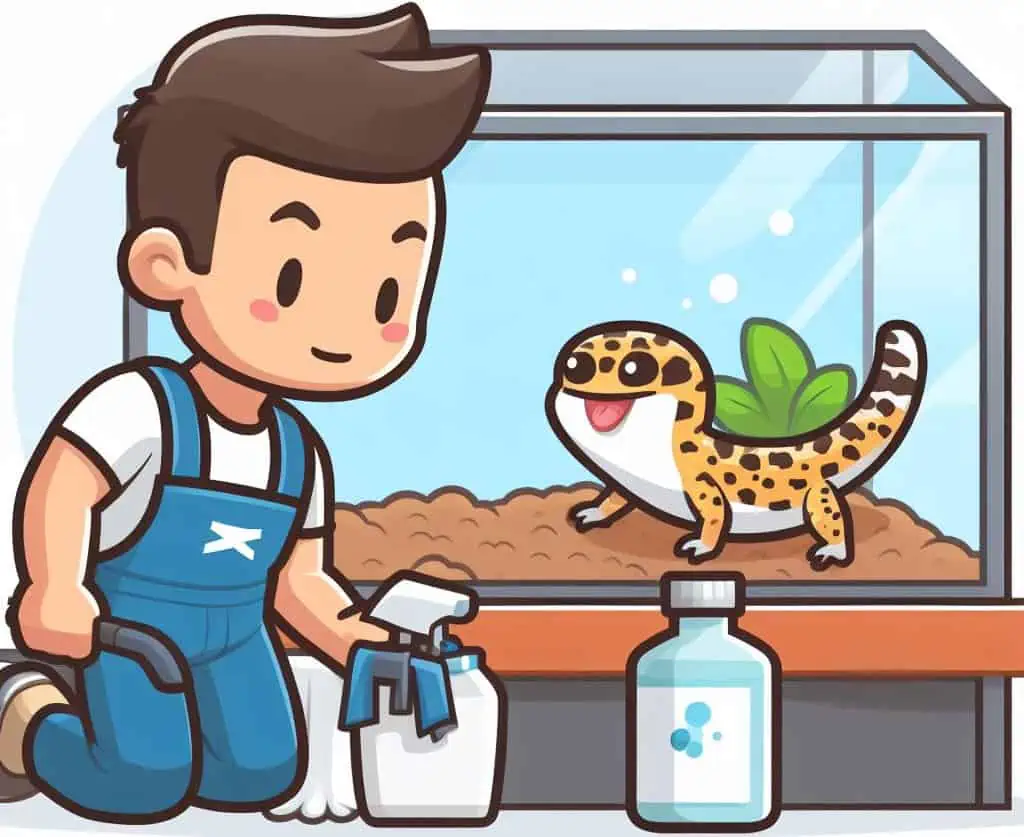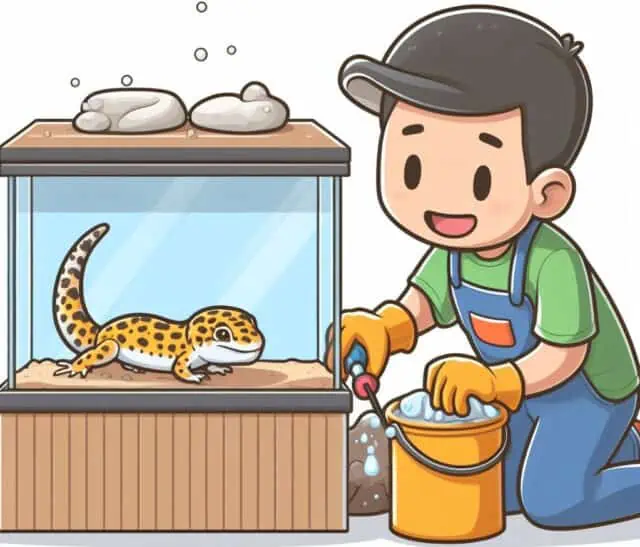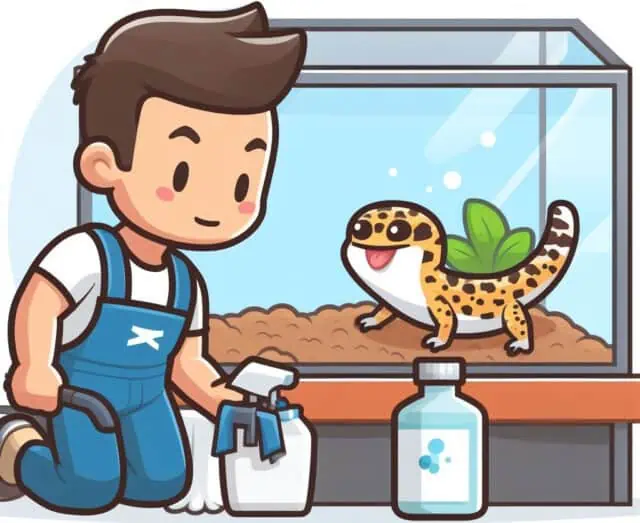Cleaning a leopard gecko enclosure is essential for the health and happiness of your scaly friend. Much like our living spaces, a tidy and sanitary habitat ensures the well-being of its inhabitants. Ensuring your gecko’s home is free from harmful bacteria, unwanted smells, and potential sources of infections is key to its longevity and overall quality of life.
Consistency is Crucial: Ensure that you maintain a regular cleaning schedule for your leopard gecko’s tank. Daily spot cleaning, weekly deep cleaning, and monthly sanitization help keep your pet in a healthy environment.
Safe Cleaning Solutions: Avoid household cleaning products with strong chemicals. Instead, always opt for reptile-friendly disinfectants or natural cleaning agents like diluted vinegar.
Minimize Gecko Stress: Reduce stress on your gecko by keeping their habitat layout consistent during and after cleaning. Transfer them to a safe holding box during the process and minimize handling.
Substrate Care: Replace the substrate during your monthly sanitization, or sooner if you notice it becoming damp, moldy, or excessively dirty.
Stay Informed: Regularly check for updates on best practices in leopard gecko care. Even small changes can make a significant difference in your pet’s well-being.
Benefits of Cleaning a Leopard Gecko Enclosure
Regularly cleaning a leopard gecko enclosure isn’t just about aesthetics; it’s vital for your pet’s well-being. Let’s delve into the reasons why a pristine habitat makes all the difference.
Firstly, a clean enclosure ensures a healthy environment. Just as we humans thrive in clean surroundings, so do leopard geckos. Regular maintenance removes waste and other contaminants, ensuring your gecko has the best possible environment to live in. It also aids in bacteria growth prevention, ensuring that harmful microorganisms don’t take root and proliferate.
Secondly, nobody likes unpleasant smells – not you and certainly not your gecko. Regular cleaning is the key to odor elimination. A buildup of waste and uneaten food can quickly lead to a smelly environment, which is unpleasant for you and stressful for your gecko.
Infection risk reduction is another crucial benefit. By removing potential sources of infection, such as mold, waste, and rotting food, you significantly reduce the chances of your gecko falling ill. Bacterial infections can be particularly nasty and, in some cases, even fatal. Prevention, as they say, is better than cure.
Lastly, there’s something to be said about the aesthetic aspect. A clean and visually appealing enclosure is a joy to look at. It becomes a centerpiece in a room and showcases your commitment to your pet’s well-being. For both the gecko and its owner, a well-maintained living space is comforting and satisfying.
Supplies Needed for Cleaning
Cleaning your leopard gecko’s enclosure doesn’t require a ton of specialized equipment, but having the right supplies on hand will make the process smoother and more effective. Here’s what you’ll need to get started.
To begin with, it’s essential to use reptile-friendly cleaning solutions. These are designed to be safe for reptiles, ensuring that no harmful chemicals linger that could harm your gecko. However, if you’re looking for alternative approaches, there are natural cleaning methods available. A solution of white vinegar and water, for instance, can be an effective and safe cleaning agent.
Now, let’s get into the specifics of the supplies needed:
- Latex Gloves: Before you start, ensure your hands are protected. This not only keeps your hands clean but also prevents any possible transfer of oils or contaminants from your skin to the enclosure.
- Reptile-friendly Soap or Dish Soap: For general cleaning, a gentle soap is ideal. Ensure it’s rinsed off thoroughly to avoid any residue.
- Paper Towels: These are perfect for wiping down surfaces and absorbing moisture.
- Sponge: Essential for scrubbing and ensuring every nook and cranny is spotless.
- Reptile-friendly Disinfectant Spray: After the general cleaning, a quick spray-down with a safe disinfectant will ensure all harmful bacteria are eliminated.
- Large Bowl for Rinsing: This will come in handy to rinse off any items from the enclosure before placing them back.
- Mesh Scoop for Cleaning Substrate: This tool is excellent for sifting through the substrate to remove waste, uneaten food, or other debris.
How To Clean a Leopard Gecko Cage: Step by Step
Maintaining a clean habitat is crucial for your leopard gecko’s overall health and well-being. A methodical approach ensures you don’t miss out on any details, enhancing the environment’s safety and cleanliness.
Step 1: Moving the Gecko Temporarily
Before diving into the cleaning process, the first step is ensuring the safety and comfort of your leopard gecko. It’s essential to move the leopard gecko temporarily to minimize its stress and keep it away from potentially harmful cleaning agents.
Here’s the importance of this action: By removing the gecko from its tank, you not only protect it from chemicals but also prevent it from becoming agitated by the cleaning process. Stress can have adverse effects on reptiles, so this step is all about prioritizing their well-being.
So, how exactly do you go about this?
- Prepare a Holding Box: This doesn’t have to be anything fancy. A simple container with a secure lid will do (like a plastic tub). Ensure it’s spacious enough for the gecko to move around comfortably.
- Place Paper Towels at the Bottom: Paper towels act as a temporary substrate, offering your gecko some grip and making it feel secure in the holding box.
- Ensure Good Ventilation: If you’re using chemicals during the cleaning process, ensuring that the holding box is in a well-ventilated area is crucial. This ensures that your gecko doesn’t inhale any potentially harmful fumes.
Step 2: Empty the Enclosure and Clean Dishes
The next essential step in cleaning your leopard gecko’s habitat involves emptying the enclosure and ensuring all its components are thoroughly cleaned. This doesn’t just make the environment visually appealing but also helps in removing any harmful bacteria or germs that might pose risks to your gecko.
Start by taking out all the items inside the tank. This includes plants, hides, water dishes, calcium dishes, and any other decor or items present. By doing so, you get clear access to every nook and cranny of the tank, ensuring a thorough clean. The heat mats should also be removed.
If you’re using a carpet as substrate, now’s the time to take it out. Once removed, let it air out and dry. This helps in eliminating any moisture which could potentially become a breeding ground for harmful bacteria.
It’s essential not to overlook the smaller items. Wash all the dishes and other removed items using a mix of gentle soap and hot water. This combination is effective in killing off any germs present.
With all items removed, now focus on the tank itself. Begin by washing it with a solution of water and dish soap. Scrub away any stubborn stains or residues. Once you’re done with the soap, rinse the tank thoroughly.
After rinsing, you can use vinegar, a mild bleach solution, or a reptile-friendly disinfectant to disinfect the tank. Remember, if you’re using bleach, it’s crucial to rinse the tank multiple times afterward to ensure no bleach residues remain.
Step 3: Cleaning the Leopard Gecko’s Tank
The centerpiece of your leopard gecko’s living environment is the tank. Ensuring it’s meticulously cleaned is not only about aesthetics but also vital for the health and well-being of your pet. The process involves several cleaning steps, but with the right precautions, it can be executed smoothly without compromising the tank hygiene or the health of your leopard gecko.
1. Safety First: Before embarking on the cleaning process, ensure you’re wearing gloves. This will protect your hands from any disinfectants used and also prevent any oils or contaminants from your skin transferring to the tank.
2. Scrub Away: Begin with scrubbing the tank’s walls and floor to remove any debris, stains, or fecal matter. A sponge or a soft brush can be used for this purpose.
3. Soap and Rinse: After scrubbing, wash the tank with a mild reptile-friendly soap. Ensure the soap is thoroughly rinsed off. Residues can be harmful to your leopard gecko’s health.
4. Disinfection: After the basic cleaning, disinfect the tank using a reptile-safe disinfectant. This step is essential for eradicating any lingering bacteria or germs that might be harmful to your gecko.
5. Rinse Thoroughly: Once disinfection is complete, rinse the tank multiple times with clean water. This ensures no disinfectant residues are left behind, which could potentially harm your pet.
6. Dry Completely: Allow the tank to air dry completely. Moisture can be a breeding ground for bacteria, so ensuring the tank is bone dry is crucial for maintaining optimal tank hygiene.
Step 4: Replace Bedding, Put Fresh Water and Dry Everything
Ensuring a clean, dry, and comfortable habitat is essential for the overall health and happiness of your leopard gecko. After cleaning, it’s time to reassemble their home, ensuring that every component is fresh and in the best condition possible.
Start by taking out the old carpet or bedding. These can harbor bacteria and waste over time. Replace it with a fresh substrate suitable for leopard geckos. This provides a clean surface for your gecko and reduces the risk of infections.
Clean, fresh water is pivotal for your gecko’s well-being. Empty the old water from the water dish, clean it, and refill it with fresh water. This will ensure your gecko has access to uncontaminated water for drinking and hydration.
It’s imperative to make sure that all the items you’ve cleaned — from the tank’s walls to hides, dishes, and other accessories — are completely dry. Moist environments can promote the growth of mold and bacteria, which are harmful to leopard geckos.
Ensure the dried carpet is free from any dampness before placing it back in the tank. The same applies to other accessories.
Step 5: Carefully Move the Gecko Back
After thoroughly cleaning and arranging the leopard gecko’s habitat, the final yet significant step is to safely reintroduce the gecko to its freshened environment. It’s of utmost importance to handle this step with care to avoid causing any undue stress to your pet.
When placing items back into the tank, try to keep their positions as close to the original as possible. Leopard geckos are creatures of habit and become familiar with their surroundings. Suddenly changing the position of hides, dishes, or other items can cause them to feel disoriented in their own enclosure.
Just as you wouldn’t appreciate someone drastically changing your living space without notice, leopard geckos prefer a sense of familiarity in their enclosures. Refrain from adding new decors or making significant changes immediately after cleaning. If you decide to introduce new items, do so gradually over time.
When it’s time to move the gecko back into the tank, handle it gently and try to minimize the time it spends out of its habitat. Ensure that the environment inside the tank is comfortable — not too damp or too dry — before reintroducing your pet.
How Often Should You Clean a Leopard Gecko’s Tank?
A clean environment is paramount for the well-being of any pet, and leopard geckos are no exception. Regular cleaning not only ensures the health and comfort of the gecko but also extends the life of the tank and its accessories. However, the frequency of cleaning varies based on specific tasks.
Spot Cleaning (Daily)
Spot cleaning is a routine task vital for a leopard gecko’s tank maintenance. Unlike a full-tank cleanup, spot cleaning focuses on promptly addressing minor messes within the enclosure.
This involves removing uneaten insects and diligently scooping up any poop found. By doing this on a daily basis, owners ensure that the environment remains a clean and healthy space for the gecko.
Deep Cleaning (Weekly)
While spot cleaning addresses daily messes, a deep cleaning routine on a weekly basis ensures the overall hygiene of the leopard gecko enclosure. This more thorough cleaning process entails removing all items from the tank and diligently rinsing and soaking them in warm soapy water.
Afterward, the tank surfaces themselves are cleaned with a reptile-safe disinfectant, ensuring no harmful residues are left behind. Furniture and accessories within the enclosure aren’t exempt from this cleaning regimen either.
One crucial aspect of this deep cleaning process is to make certain everything is completely dry before reassembling the enclosure.
Sanitizing (Monthly)
Beyond the regular spot and deep cleaning routines, a monthly sanitization of the leopard gecko’s enclosure is essential. This type of deep cleaning serves as a preventative measure to eliminate potential harmful microorganisms and maintain a consistently healthy environment for your pet reptile.
In the sanitizing process, some primary tasks come to the fore. These include cleaning the tank thoroughly to remove any stubborn residues or build-up, replacing the substrate with a fresh layer, disinfecting dishes to ensure no bacterial growth, and meticulously cleaning the various accessories found within the enclosure.
FAQs – Frequently Asked Questions
Can I use household cleaning products on my leopard gecko’s tank?
While some household cleaning products might seem convenient, it’s essential to avoid any with strong chemicals. Instead, opt for reptile-safe disinfectants or natural cleaning agents like diluted vinegar or soap.
How do I know when it’s time to replace the substrate?
It’s advisable to replace the substrate during your monthly sanitization routine. However, if you notice excessive waste build-up or the substrate becoming damp and moldy, it’s time for a change.
Is it harmful to move my gecko too often during cleaning?
Constant movement can be stressful for leopard geckos. It’s best to transfer them to a safe holding box during the cleaning process and move them as minimally as possible.
What if my gecko seems stressed or disoriented after cleaning?
It’s not uncommon for leopard geckos to feel a bit disoriented after their environment has been cleaned. Keep their original habitat layout consistent, avoid introducing new decor immediately after cleaning, and give them time to readjust.
Can I add new plants or accessories right after cleaning?
While it’s exciting to introduce new items, it’s best to wait a day or two after cleaning. This allows your gecko to re-familiarize itself with its habitat without the added stress of unfamiliar items.







